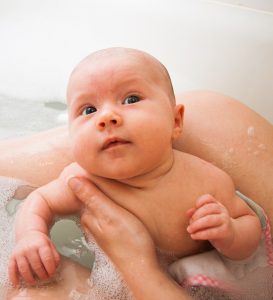Baby Bath Conditioning: How to Familiarise Your Baby With Water and Prepare Them for Swimming Lessons
Preparing your baby for swimming lessons
Babies arrive in the world from the warm liquid environment of their mother’s womb, free of inhibition and without an inbuilt fear of water. Typically, however, a baby’s innate responses to the aquatic environment are lost at around the age of 12 months, and they may sometimes develop a fear of water or a sense of feeling uncomfortable in water around this age. That’s why baby bath conditioning is so important.
Early introduction to the water has also been shown to improve the physical and psychological development of baby, and to enhance their strength, mobility, concentration and independence.
In this article we will discuss baby bath conditioning: tips on bathing a newborn, positions you can hold them in the bath, how to familiarise your baby with water, how to and teach them to hold their breath and prepare them for swimming lessons, and how to make sure you do it all as safely as possible.
Tips on bathing a newborn
Many new parents worry about bathing their newborn. Here are some tips on when and how to do it to make sure it’s an enjoyable experience for everyone:
 Bathing does not increase the risk of infection to an umbilical cord stump, so you don’t need to wait for the stump to heal completely before getting your newborn into the tub.
Bathing does not increase the risk of infection to an umbilical cord stump, so you don’t need to wait for the stump to heal completely before getting your newborn into the tub.- Choose a time for bathing when there will be minimal interruption and plenty of time for undivided attention.
- Bathing before bedtime will help your baby relax and sleep better.
- Avoid baths just before or after feeding – if a baby is hungry they won’t relax and enjoy the experience, and if they are full from a feed there is a risk of them ‘spitting up’.
- Never leave your child unsupervised or alone. If you need to leave the bathroom to answer the door or phone, wrap your baby in a towel and take them with you.
- Bathing your baby can be much easier if you join them in the bath. Handling a wet, slippery body is challenging, and being in the bath with your baby means better security and safety for all.
- Minimising heat is important, so make sure the air and bath temperatures are comfortable and appropriate for your baby’s sensitive skin.
3 positions for baby bath conditioning
There are 3 positions you can place your baby in to allow them to experience different sensations while in the water.
Before you begin, make sure the bath doesn’t have too much water (even with the parent in the bath with baby, only a few inches of water are required). And remember, and at no stage should your newborns face/mouth/nose be in or under the water.
First position for baby bath conditioning
In the first position, parents lower themselves into the water, lying on their back. Baby is then placed stomach down on their parent’s chest/stomach in a way that allows them to snuggle and feel close contact with their parent.
The parent then gently pours water from a cup over baby’s back and legs (which, for safety reasons, remain out of the water and on top of their parent’s torso) allowing the baby to feel the warm stimulation of the water running over their skin.
Second position for baby bath conditioning
Once the baby has been introduced to the water in this way, the parent may sit up and cradle their baby in front of them (between their legs).
Supporting baby with one hand behind their neck/head and the other behind their lower back area, the parent then gradually lowers their baby into the water so that the back of baby’s head and ears are submerged, with their face remaining clear of the water. The back of their head must be supported at all times by the parent. This cradle position allows for face-to-face contact between parent and child.
Once comfortable in this position, the parent may remove their supporting hand at the base of the baby’s spine to allow the baby a greater degree of independence and increased freedom to experience the buoyancy of the water.
Third position for baby bath conditioning
The third position involves the baby being held tummy down in the water with the parent seated. Baby must be constantly supported to keep the mouth and nose clear of the water.
In this position, the parent’s hands are held under baby’s armpit with thumbs pointed skywards. The palms of the hands are rotated upwards to allow the wrists to come together to support baby’s chin and to allow the baby to rest their head on the hands of the parent.
Baby lies in a horizontal position to the water, with their head kept up (supported by Mum or Dad’s hands) and their backside close to the surface of the water. Babies love this prone position because it gives them freedom to move and extend their legs in a motion that is otherwise not possible on land. It also allows the parent freedom to swish baby from side-to-side and back-and-forth. And it even allows baby to push off the end of the bath, which can strengthen the legs of the baby and give them an added sense of security.
Once the child is comfortable in the water in these positions, parents may commence teaching breath control via stimulus response as detailed below.
The trigeminal reflex of newborns prevents water inhalation
Newborns have a trigeminal reflex that enables them to automatically stop breathing for a short period of time if they are submerged underwater or if water touches the nasal/mouth region of their face. The reflex also helps prevent infants from inhaling water (even with their mouths wide open) for a short period while underwater.
However, you shouldn’t try to ‘dunk’ or submerge your infant prematurely. Babies need to be conditioned to water first. You can use a simple routine at bath time that will guarantee a simple and natural transfer from above water to underwater (and from bath to swimming pool). Water conditioning develops a child’s breath control and breath-holding capacity in preparation for submersion.
Teaching your baby to hold its breath around water – stimulus response
Through verbal and visual cues, babies can be taught to hold their breath as a small amount of water is gently poured onto their face. You can use the following stimulus response technique when your baby is having a bath:
- Take half a cup of water, preferably in a brightly coloured cup to add visual stimulation.
- Gain your child’s attention using the cup as a visual cue.
- Using the key words ‘Child’s Name, Ready, Go!’ pour the cup of water evenly and consistently across the child’s head. This Cue, ‘Name, Ready, Go! is extremely important in the conditioning process. The phrase is a trigger which tells the child to prepare to hold their breath.
- Congratulate and provide positive reinforcement to your baby. This will increase the child’s enthusiasm, confidence and relaxation towards this process, and with being in the water.
Once your child is comfortable with having a small amount of water poured over their face, you may increase the amount of water in the cup. Or, alternatively, you can gradually increase the amount of time it takes to pour the same amount of water out of the cup. This technique improves the breath-holding capacity of your baby.
And of course, your baby must be supervised at all times throughout this water-conditioning activity.
When to stop the water-conditioning process
If your child is crying, distressed or has ingested water you should stop the conditioning process and remove them from the bath.
You can use lots of positive reinforcement if your baby is upset or has accidentally ingested water. Also, vibrant toys or a new activity can often provide an effective distraction.
Why not jump in the bath with your baby?
Sharing the bath with your baby during water conditioning offers a number of benefits. Firstly, it prevents you from being distracted. Secondly, it allows easy access to hold your baby upright in the bath so that water is free to flow down their face rather than up their nose.
Thirdly, sharing a bath with your baby allows you to form a stronger bond of trust while conditioning them to water. And lastly, it can be a lot of fun to share this part of your child’s development.
So don’t be afraid to get in the bath and get wet with your infant as part of their preparation for your babies swimming lessons!
How to help your child relax during the process
If you can remain calm and relaxed during this process, this will help your baby feel the same way. Your baby can feel if you are nervous or stressed.
Remember, the aim of conditioning is to provide a positive introduction to water, so keep a close eye on your baby’s reactions to different experiences.
How to be safe at bath time
In Australia an average of 19 children drowns in bathtubs annually. And the majority of these deaths occur silently and in seconds, in a few centimetres of water while the parent or caregiver is not in the room.
A number of simple steps can be taken to make sure bath time is safe.
Never leave your baby unattended in the bath
It’s easy to get distracted by the doorbell, food cooking on the stove, your mobile phone ringing, or another child crying. However, you should never leave your baby in the bath—for any reason. If you need to leave the room, simply scoop them up, wrap them in a towel and take them with you.
Get everything together before starting the bath
All necessary equipment such as the child’s clothes, nappies, dry towels, bath toys and soaps should be organised prior to running the bath. This helps ensure you can provide constant arm’s reach supervision of the infant throughout the bathing period.
Don’t get an older child to watch a baby in the bath
An older child left in charge of a younger child may not recognise or react fast enough to an incident. So don’t ask an older child to watch a baby in the bath while you go and do something else. If you need to leave the bathroom, take the baby with you.
Share the bath with your baby
In the case of young infants, you can hop in the bathtub and help make bath time a bonding experience. This also minimises the risk of distraction. The recommended depth of water for a bathing baby is between 5-8cm.
Use non-slip mats in the bath
Non-slip mats can help prevent immersion accidents, and are a wise investment for baby bath time.
Consider using a chair or cushion
You should consider using a small fold-up chair, stool or cushion during the bathing supervision period. These can provide comfort and means you are less likely to move from your monitoring position.
Empty bathwater immediately after the bath
Remember to empty the bathwater immediately after the bath has finished. This removes any risk of a bathwater immersion incident at a later time.
Swimming lessons for babies
At Hampton Swim School, we provide swimming lessons for babies, toddlers and children on the South Side of Brisbane.
